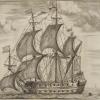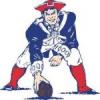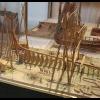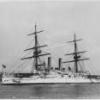Supplies of the Ship Modeler's Handbook are running out. Get your copy NOW before they are gone! Click on photo to order.
×
-
Posts
3,152 -
Joined
-
Last visited
Reputation Activity
-
 trippwj reacted to _SalD_ in Phantom by _SalD_ - FINISHED - 1/8" scale
trippwj reacted to _SalD_ in Phantom by _SalD_ - FINISHED - 1/8" scale
Coppering the hull is proceeding. I decided to follow the kit directions for cutting the copper foil by splitting the 1/4" wide strip in half making two 1/16" wide strips. I did this because I wanted to use plates longer than 2'-0" (1/4") as in the practicum. I measured the length of the plates from the ship plans and scaled them to be approximately 3'-0" to 3'-6" long. I decided to make my plates 3'-2" long, leaving 2" for the overlap. The plate lengths were measured out using dividers and cut using an x-acto knife and straight edge. Applying the plates started out slow at first but once I got more comfortable with the procedure my pace picked up some. I used my wallpaper seam rolled to set the plates in place once they were positioned correctly.
-
 trippwj got a reaction from SkerryAmp in HMAT Supply by riverboat - FINISHED - Jotika/Caldercraft- 1/64th scale
trippwj got a reaction from SkerryAmp in HMAT Supply by riverboat - FINISHED - Jotika/Caldercraft- 1/64th scale
Outstanding!!! Beautiful work, Frank. Congratulations!!!
-
 trippwj got a reaction from popeye the sailor in Emma C Berry by trippwj - Model Shipways - Scale 1:32
trippwj got a reaction from popeye the sailor in Emma C Berry by trippwj - Model Shipways - Scale 1:32
Greetings - at sorry to have neglected this lady for so long!
The ECB gets my attention this month - have beveled and now installed 4 frames since the first (may not seem like much, but after taking so long to get the first 9 in, 4 in les than a week is really moving!!!)
So, here is her present status. I have frames 14 and 15 in preparation right now, hope to get them in by tomorrow evening.
-
 trippwj reacted to Dan Vadas in HMS Vulture 1776 by Dan Vadas - FINISHED - 1:48 scale - 16-gun Swan-class sloop from TFFM plans
trippwj reacted to Dan Vadas in HMS Vulture 1776 by Dan Vadas - FINISHED - 1:48 scale - 16-gun Swan-class sloop from TFFM plans
Thanks once again for the "likes" and the nice comments to Robin, Brian, Piet, Ben, Popeye, Michael, Nils and Mohamad. Always appreciated .
Head Works - Cheeks
I've started work on one of the most interesting and complex parts of the build - the work around the Head of the ship.
First thing to do was remove the forward support which holds the hull in position on the baseboard. It doesn't really get in the way as such, but work on the lower cheek especially is a lot easier without it being in the way and there was the problem of it pulling the Knee of the Head out of position as work commenced in this area. I hadn't used the aft support for a long time - before the rudder was installed actually - so I had to move it backward a bit.
This starts off with making the Lower and Upper Cheeks, which laterally brace the Knee of the Head. It's quite tricky to get the inner faces to mate up with the Knee and the curvature of the hull. A card template was used to get the inner faces somewhere near right, but my first attempt still resulted in a failure. The second go was spot on .
The main problem is that there is a substantial bevel on the inner face where it curves around the hull to allow the forward part of the cheek to run at the correct angle on the knee. It took me a couple of hours to sort it out, but at least I now know where I'm going with the other three.
The forward part of the cheek also has a slight upward curvature, so I made the piece from thicker stock and sanded that into it. You may be able to see this in the next pic against an unshaped blank :
Two moldings were scraped into the outer face :
Danny
-
 trippwj reacted to pete48 in Muscongus Bay Sloop by pete48 - FINISHED - SMALL
trippwj reacted to pete48 in Muscongus Bay Sloop by pete48 - FINISHED - SMALL
Today, I worked on Keel # 4 . I first layed out the deck, and then the Cabin / Cockpit coamings ( I went with the same size as Keel # 5 1/16" thick ) I then cut out the deck and coamings , I then put the Coamings in alcohol ( I knew that I would need to soak them for a while ) I then turned my attention to fitting and installing the deck , I then installed the Coamings . Here are the results
-
 trippwj got a reaction from robin b in Nautical and Model Building Resources
trippwj got a reaction from robin b in Nautical and Model Building Resources
I am a non-recovering bibliophile...according to Wikipedia,
The classic bibliophile is one who loves to read, admire and collect books, often amassing a large and specialized collection. Bibliophiles do not necessarily want to possess the books they love; an alternative would be to admire them in old libraries. However, the bibliophile is usually an avid book collector.
Yep - that's me! Actually, it is apparently contagious. Between my long suffering Admiral in Chief who has upwards of 200 cookbooks and our other assorted collection, we have conservatively 1,500 volumes on a wide array of topics from History to Philosophy to our specialized Terrorism collection (work related, of course) and now nautical themed. The attached document is a listing of the print, PDF and a few on-line documents that are a part of the collection. Feel free to offer suggestions on books I should consider adding to my collection, and Happy Modeling!
Wayne
Neither should a ship rely on one small anchor, nor should life rest on a single hope.
Epictetus
Waynes Nautical Resource List ver 2 rev 11Feb13 for MSW.pdf
-
 trippwj got a reaction from newbuilder101 in San Felipe by newbuilder101 (Sherry) – Scale 1:96
trippwj got a reaction from newbuilder101 in San Felipe by newbuilder101 (Sherry) – Scale 1:96
All I can say is WOW! That is some very impressive detail work, Sherry. Nicely done!
-
 trippwj reacted to newbuilder101 in San Felipe by newbuilder101 (Sherry) – Scale 1:96
trippwj reacted to newbuilder101 in San Felipe by newbuilder101 (Sherry) – Scale 1:96
Another small update.....
New additions include the vertical strips of wood on the hull mid-ship. I'm not sure of the name or function of these timbers, but I'm wondering if they could be for protection of the hull when the lowering of the ship's boats?
Also added are more ornamentation pieces, such as the eagles and the piece at the top of the gallery door.
Now to make these same pieces for the port side.
-
 trippwj got a reaction from uss frolick in Deck beam Scarphs?
trippwj got a reaction from uss frolick in Deck beam Scarphs?
Recognizing that these are from a much later era than the original query, here are a couple of snippets from Fincham (1825) - An Introductory Outline of the Practice of Ship-building available via Google Books in PDF (I have not been able to locate an edition with the plates as yet but continue to seek same)
Concerning the Keel (Fincham, 1825 – page 9)
4. As the keel cannot be obtained in one piece, as to length, several pieces are bolted together lengthways, by what-is called a side or vertical coak scarph; the scarphs being in length about three times the depth of the keel. The coaks are for the support of the bolts, especially to resist the strain when the butts of the scarphs are being caulked; they are one-half the length of the scarph, and their breadth one-third its depth.
.
5. The scarphs are bolted with from six to eight bolts; eight, from frigates upwards, and six to smaller vessels: half of the bolts are driven from each lip side, with a ring upon the head, and clenched upon a ring on the opposite side.
.
6. The French and most other nations have flat or horizontal scarphs; but as these scarphs tend to weaken the keel, in the direction in which it is most subject to strain, more than the side scarphs, the English mode is preferable; for the keel bends vertically, which brings a tension on the upper or lower fibres, according as hogging or sagging takes place, which fibres are cut off, in a greater number in these scarphs, to let in the lips; and when sagging takes place there is a tendency to open the joint at the lower lip; this opening will cause the scarphs to leak, except a stopwater be placed at the intersection of the joint of the scarph with the outer edge of the garboard seam, or by increasing the length of the scarphs.
Concerning Deck beams (Fincham, 1825 page 70) –
169. The beams are distinguished into single pieces, two ( b ), three ( c ), and sometimes four piece beams (f and g): the length of the beams and the timbers that can be provided to make them will determine the number of pieces they are to be composed of, which should always be as few as possible; for the quantity of timber required to make them will be increased with the number of pieces, because the number of scarphs is increased.
170. When a beam is made or composed of more than one piece, the pieces are united together with vertical scarphs. If in two pieces ( b ), the scarph is 1/3, if in three pieces ( c ) 1/4, and when in four pieces (f and g) 1/5 the length of the beam.
171. The scarphs are distinguished into right and left hand scarphs, and are named by the hand that is on the side of the angle, or the side from which the wood to form the scarph is taken off; when at the side end, the face is towards the scarph and looking upon the upper surface; they are bo1ted with from seven to nine bolts; so as to make their distances apart from 16 to 18 inches, placed alternately. about 2 1/2 to 3 1/2 inches from the upper and lower part of the beams. An equal number of them is driven from each lip side and clenched upon the opposite; in addition to these bolts, one nail is driven into each lip on the opposite edge to the nearest bolt, and one bolt is frequently driven up and down in each lip to prevent its splitting.
-
 trippwj reacted to _SalD_ in Phantom by _SalD_ - FINISHED - 1/8" scale
trippwj reacted to _SalD_ in Phantom by _SalD_ - FINISHED - 1/8" scale
Finished the Launching Ways. Took a few liberties with the ground way support stacks. I extended the bottom timbers and added an additional timber at the top. As a structural engineer it appeared that they needed to distribute the load more and to keep the ground way rails from moving laterally. Hope that's not against the rules.
I guess I have no more excuses now, I'll have to start coppering the hull.
-
 trippwj reacted to druxey in Nautical and Model Building Resources
trippwj reacted to druxey in Nautical and Model Building Resources
Darn. So I, too, must be a bibliophile. Must add that to the ever-growing list of perjoratives that describe me....
-
 trippwj reacted to wq3296 in Deck beam Scarphs?
trippwj reacted to wq3296 in Deck beam Scarphs?
Greetings Jud,
It is understood that deck beams do more than hold up the decks. In fact, they function as a diaphragm to brace the perimeter of a ship: much the same function as the floor structure in a building.
wq3296
-
 trippwj got a reaction from 42rocker in Nautical and Model Building Resources
trippwj got a reaction from 42rocker in Nautical and Model Building Resources
While I haven't completed the process as yet, I am expanding my list to include the link to downloadable books. Also have added quite a bit to the print books - guess I ought to update those as well. Is there anything in particular you folks could recommend to make the list more useful for you?
-
 trippwj got a reaction from jcurtis55 in Book Review - Captain Blakeley and the Wasp: The Cruise of 1814
trippwj got a reaction from jcurtis55 in Book Review - Captain Blakeley and the Wasp: The Cruise of 1814
Captain Blakeley and the Wasp: The Cruise of 1814
Stephen W. H. Duffy
Hardcover: 348 pages including Index, extensive Notes and Bibliography.
Publisher: US Naval Institute Press (2001)
Language: English
ISBN-10: 1557501769
In celebration of the 200th anniversary of the start of his historic, and ill fated, cruise, it is my honor to present to you a brief review of a narrative of Captain Johnston Blakeley's career in the early American navy, culminating in one of the greatest raiding cruises every undertaken.
There are many tales of the accomplishments of America’s young navy during the War of 1812, and several of the most famous names in American Naval History were blazed into the national consciousness during that conflict. Although the most successful American naval officer of the War of 1812, Johnston Blakely never enjoyed the fame that he had for so long desired. His fame was posthumous.
In Captain Blakeley and the Wasp: The Cruise of 1814, Stephen Duffy tells, in a readable and coherent fashion, the story of Master Commandant Johnston Blakeley and the highly successful cruise of the American sloop of war Wasp in 1814. Duffy draws on archival information from numerous institutions to introduce the reader to the young Blakeley, tracing his youth and formative years through to his early years serving under Thomas Truxton on the President and John Rodgers on the John Adams to his command of the brig Enterprise in 1811. Blakeley’s skills and ambition are rewarded – he is sent to Newburyport, Massachusetts to supervise the construction of the Sloop of War Wasp.
Duffy demonstrates his passion for detail and accuracy as he chronicles the building of the Wasp and Blakeley's struggles to outfit and crew his new ship, an effort made more difficult by national politics and by rivalries within the Navy. Designed by Naval Constructor William Doughty as a commerce raider, Wasp was rated at 509 tons and 22 guns with a crew of 173. Blakeley left port on May 1, 1814, at the helm of the newly commissioned Wasp.
Blakeley captured his first prize on June 2, 1814. Within the following month, the Wasp captured and burned four more prizes. Blakeley secured his place in American naval history on June 28, 1814. Blakeley and his crew chased and brought to battle the Royal Navy’s HMS Reindeer, a Cruizer class brig sloop of 18 guns. One of the hardest fought battles of the war followed, and when it had concluded, Blakeley’s guns had overpowered and reduced the British vessel to a drifting hulk. Also damaged, Blakeley sailed to L’Orient, France to offload prisoners and seek repairs. En route, despite the damage incurred during the battle with the Reindeer, the Wasp still captured two more prizes.
The Wasp was back at sea by August 27, and Blakeley set course for Gibraltar. He continued cruising successfully throughout the fall, even winning a battle over the HMS Avon. As news of Blakeley’s success filtered back to the United States in October and early November, he became a hero, and Congress promoted him to Captain on November 24. Meanwhile, the Wasp’s return was long overdue, and rumors swirled concerning the ship’s fate. The British never made claims to sinking the ship, but the Wasp vanished somewhere on the Atlantic, possibly foundering in a gale. The last confirmed sighting was by a Swedish crew on the Adonis. They saw the Wasp on October 9, 1814, some 225 miles southwest of Madeira.
Duffy is able to provide a cogent and informative interpretation of the available archival records, and brings Blakeley to life as a tragic hero of his time. Faced with the common constraint imposed on any student of history, Duffy was faced with the paucity of primary source accounts from Blakeley and his close associates, as well as the conflicting accounts in the British and American records. Duffy was very selective and effective in his use of reasonable speculation about the thoughts of the young officer regarding various situations. Mr. Duffy has succeeded in providing not just a story of a young man who was in the right place with the right ship at the right time, but also presents a well-researched and documented study of a junior officer in the small American navy at the beginning of the 19th Century.
-
 trippwj got a reaction from NAZGÛL in Emma C Berry by trippwj - Model Shipways - Scale 1:32
trippwj got a reaction from NAZGÛL in Emma C Berry by trippwj - Model Shipways - Scale 1:32
Greetings - at sorry to have neglected this lady for so long!
The ECB gets my attention this month - have beveled and now installed 4 frames since the first (may not seem like much, but after taking so long to get the first 9 in, 4 in les than a week is really moving!!!)
So, here is her present status. I have frames 14 and 15 in preparation right now, hope to get them in by tomorrow evening.
-
 trippwj reacted to popeye the sailor in US Frigate Essex by trippwj - Aeropiccola - 1:70 Scale - POB
trippwj reacted to popeye the sailor in US Frigate Essex by trippwj - Aeropiccola - 1:70 Scale - POB
looking great Wayne........looks to me like there are enough frame there {ribs} to do a fairly decent butt shift pattern. do you intend to plank around the deck line before you plank the deck? pieces could be used around the inner edge for the ones that won't fall on a rib frame. that's a call you'll have to make when you get there looks really sweet!
your painter is really good!..........extra rations for that man!
-
 trippwj got a reaction from coxswain in US Frigate Essex by trippwj - Aeropiccola - 1:70 Scale - POB
trippwj got a reaction from coxswain in US Frigate Essex by trippwj - Aeropiccola - 1:70 Scale - POB
Greetings, all. Have taken a tip from the Master of Cotton Balls (Sjors) and will be trying to split my time a month at a time amongst builds. The Essex will now be relgated to a shelf for the next month whilst I get back to my sorely neglected Emma C. Berry. Here, then, are a couple of shots of where I am on the Essex.
I am prepping the hull for the first planking - nearly done with the fairing, still need to cut the rabbet along the bow area.
Question - since there is no "false deck", would it be prudent to add some additional deck beams to support the deck planiking, or would that be creating work with minimal benefit (see drawing of kit structure below)?
Meanwhile, Brett (my son) has been tackling the detail painting for the stern decoration - not done yet, but progressing. He has all sorts of cool artist supplies, and found that one of his very fine artists pens was perfect for getting the tiny details around the scroll work to look better.
Still more to do, but looks a lot better than I could ever hope to accomplish!
So, until June (unless I decide to move the Harriet Lane back to the rigging table), that's it for now!
-
 trippwj reacted to Modeler12 in What are your most interesting and/or useful books
trippwj reacted to Modeler12 in What are your most interesting and/or useful books
Thank you all for all those suggestions. I will try to find all or most of them through my library.
When I posted this thread I was thinking of where I was a couple years ago when I started this model ship building. I had sailing experience, did some minor model building but was totally ignorant of all the terminology and the in-and-outs of old sailing ships. Since then many of you helped me with good references (such as Petersson's book on rigging).
So, what I had in mind were some books for beginners in this hobby. Something that could be used in addition to the plans and explanations provided in kits.
I found one book that serves that purpose (at least in my opinion). It is 'The Visual Encyclopedia of Nautical Terms Under Sail'. The tittle continues with 'An illustrated guide to the language of the great sailing ships and the men aboard them'.
The book is full of great drawings, photographs, explanations of the various parts of sailing ships, etc. etc. Although not related to modeling, it even has a wonderful section about navigation, its history, tools and the mathematics involved. Below is one page picked at random.
-
 trippwj got a reaction from 42rocker in MSB Journal
trippwj got a reaction from 42rocker in MSB Journal
The May issue of the MSB Journal is now available at http://www.modelshipbuilder.com/news.php
Table of Contents:
Tidbits from the Past
Model Ships of the Royal Museum Greenwich
Shipwrecks of the World
Framing of a Hull—Part 3
Historical Naval Shipyards
HMS General Hunter Proto-type Model—Part 1
The Book Nook
Badges: Heraldry of Canadian Naval Ships
Gene’s Nautical Trivia
-
 trippwj reacted to jud in Deck beam Scarphs?
trippwj reacted to jud in Deck beam Scarphs?
Deck beams do more than keeping the deck up, posts can do that, When a ships bow hits the next swell with the bow canted down from the swell she is riding, the upper ends of the ribs, because the planking is in compression, will want to move out because of those forces. When she crests a swell, both ends are not supported as well as amidships so the planking goes into tension and tries to push the ribs together. Without those deck beams the ship would tear its self apart. All of the structural members of a floating ship are constantly changing from tension to compression and all beams have dual rolls, one to keep the ship together and placed so the crew can live aboard. Because of the constant changing of the forces working on a ship, joints are well thought out.
jud
-
 trippwj got a reaction from Beef Wellington in Deck beam Scarphs?
trippwj got a reaction from Beef Wellington in Deck beam Scarphs?
Thought I would throw in an illustration from Rees' Cyclopedia (1820) of the deck beam scarphing on a 74 gun ship.
-
 trippwj reacted to _SalD_ in Phantom by _SalD_ - FINISHED - 1/8" scale
trippwj reacted to _SalD_ in Phantom by _SalD_ - FINISHED - 1/8" scale
Started working on the launching ways. Cut all the pieces and stained them. Made up a little jig to set the cross timbers.
Also painted the hull and marked the waterline. Almost ready to copper the hull. I wanted to finish the launching ways first so I could locate and drill the holes in the keel for the mounting pins.
-
 trippwj got a reaction from druxey in Question on waterline placement
trippwj got a reaction from druxey in Question on waterline placement
Hi, Sal - good question! I have also posted a response to your build log.
In this case, it appears that the ship sat lower at the stern than the bow - not at all uncommon for these types. Increased speed, supposedly, as well as providing the rudder more bite and increased stability.
The launch ways are angled to allow the ship to slide into the water - think of them in relation to the ground and the keel is parallel to the ways. 2.5 to 3.5 degrees was very common for launching ways - about the ideal slant to let the vessel slide in a controlled manner into the water, but not so much that she would start to move before the blocks were removed.
The waterline is in reference to the way the ship will set in the water and will not match the slant of the ways. In the water, the stern would be lower, hence that 4.5 degree angle as opposed to the ways. They are really two totally different and unrelated sets of angles.
the masts also showed different amounts of "rake" - in general, the fore mast had slightly less rake or angle than the aft (main) mast. This was very common across nearly all ship types.
-
 trippwj got a reaction from druxey in 177x ships - British vs US design, what are the differences?
trippwj got a reaction from druxey in 177x ships - British vs US design, what are the differences?
Well put, Jason, and there is the essence of the issue - at the time in question (177x), there was no true American "Admiralty" to make those decisions - they issued general requirements to purchase "Sloops" or "Schooners", then for some "Frigates". Individual colonies then also had vessels built, but to no set mold or designs. The first effort at a standard design criteria wasn't until the first 6 frigates were ordered in the 1790's - and even those, whilst built based on the model and preliminary draughts by Humphreys, varied dramatically in final product, influenced by the builders personal vision and the Naval Captain (assigned to each as superintendent during construction). Add to that the subscription built vessels (such as the Essex) which were totally designed and built based on the local contract - then sold to the Federal government when completed.
The concept of a standardized naval construction program - plans, materials, methods and so on - was much slower to take root in America, partly a result of our desire for "States Rights" during the earliest days of the Republic, and also a general mistrust of central government.
-
 trippwj got a reaction from GaryKap in Emma C Berry by trippwj - Model Shipways - Scale 1:32
trippwj got a reaction from GaryKap in Emma C Berry by trippwj - Model Shipways - Scale 1:32
Greetings - at sorry to have neglected this lady for so long!
The ECB gets my attention this month - have beveled and now installed 4 frames since the first (may not seem like much, but after taking so long to get the first 9 in, 4 in les than a week is really moving!!!)
So, here is her present status. I have frames 14 and 15 in preparation right now, hope to get them in by tomorrow evening.












